Search the Special Collections and Archives Portal
Search Results
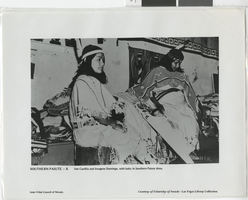
Photograph of Southern Paiute women, early 1900s
Date
1900 to 1920
Archival Collection
Description
Transcribed from photograph, "Southern Paiute - 8. Ilee Castillo and Imogene Domingo, with baby in Southern Paiute dress. Inter-Tribal Council of Nevada. Courtesy of University of Nevada - Las Vegas Library Collection."
Image
Nevada Department of Education: draft of Fiscal Year 1979 Annual Program Plan for the Education of the Handicapped, 1978
Level of Description
File
Archival Collection
John Vergiels Political Papers
To request this item in person:
Collection Number: MS-00283
Collection Name: John Vergiels Political Papers
Box/Folder: Box 030 (Restrictions apply)
Collection Name: John Vergiels Political Papers
Box/Folder: Box 030 (Restrictions apply)
Archival Component
State of Nevada Executive Budget, Fiscal Years 1991-92 and 1992-93, Volumes I-II, 1991
Level of Description
File
Archival Collection
Thomas Hickey Political Papers
To request this item in person:
Collection Number: MS-00260
Collection Name: Thomas Hickey Political Papers
Box/Folder: Box 103
Collection Name: Thomas Hickey Political Papers
Box/Folder: Box 103
Archival Component
City of Las Vegas, Nevada, fiscal year 1994-1995, final budget, approximately 1994 to 1995
Level of Description
File
Archival Collection
Thomas L. Morgan Real Estate Development Records
To request this item in person:
Collection Number: MS-01091
Collection Name: Thomas L. Morgan Real Estate Development Records
Box/Folder: Box 29
Collection Name: Thomas L. Morgan Real Estate Development Records
Box/Folder: Box 29
Archival Component
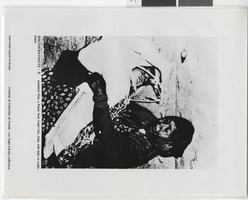
Photograph of Josephine Pete with baby, early 1900s
Date
1900 to 1920
Archival Collection
Description
Transcribed from photograph, "Southern Paiute - 9. Josephine Pete, a Paiute from Cedar City, Utah, with baby in cradleboard. Inter-Tribal Council of Nevada. Courtesy of University of Nevada - Las Vegas Library Collection."
Image
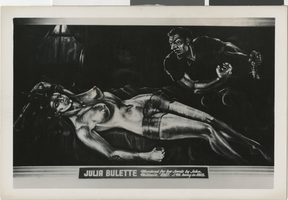
Postcard of Julia Bulette and John Millain scene, Virginia City, Nevada, 1867 - early 1900s
Date
1867 to 1939
Archival Collection
Description
An artist's depiction of Julia Bulette's theft and murder by John Millain. The caption on the front of the card reads: "Julia Bulette; Murdered for her Jewels by John Millain, 1887. J. M hung in 1868." A lengthy description printed on the back of the card reads: "Julia Bulette came to Virginia City while it was still a raw camp, and was soon among its best known figures. Reputedly a French Creole from New Orleans, tall, dark, lithe and witty, she was no ordinary lady of the line. Her secret charities were innumerable, her public services many, and her entertainments memorable for both cuisine and conversation. During the deadly black-water plague of 1861, she made her house into a hospital, nursed the stricken miners, and pawned her belongings to help their families. She was chosen an honorary member of Engine Company Number 1, but, not content with honorary status, attended the fires, worked a stirrup pump, and served refreshments to the Company afterwards. She was not one to seek obscurity or tolerate condescension. In the flush years of the first boom, she paraded C Street daily in a coach with four aces fanned upon the door, and sat nightly in her own box at the opera house, with a sable cape across her shoulders. When the ladies of the upper city sought to confine her activities, she retaliated by crashing their parties and making them her own. As a result, her violent death during the night of January 20, 1867, precipitated a cold war of the sexes. When her funeral procession, long, entirely masculine, and led by a band playing a dead-march, moved out B Street toward Old Flowery Cemetery, the wives in the hill mansions sat behind closed doors and drawn shutters, though even those could not defend them from the sprightly, returning strains of "The Girl I Left Behind Me." And conversely, when John Millain was arrested, some months later, after selling articles recognized as Julie's, his trial by the men was something less than impartial, but he was constantly visited in prison by women who showered him with gifts and tears. That his hanging, in April of 1868, drew the largest crowd in Virginia's history to the hollow north of town where the gallows was erected, the women to the ringside seats and the men to the slopes behind them, was less a tribute to Millain himself than a result of the fact that he was dying as the murderer of Julie Bulette, more nearly a Queen of the Comstock than any of her wealthy "betters" who vied for the title. "Sazarac" Virginia City, Nevada."
Image
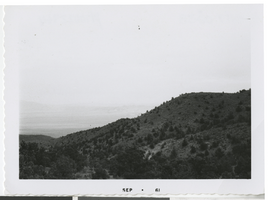
Photograph of unidentified hills, (Nev.), 1900-1920
Date
1900 to 1920
Archival Collection
Description
Unidentified desert landscape in Nevada.
Image
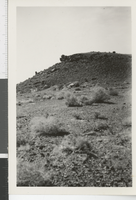
Photograph of a desert landscape, (Nev.), 1900-1920
Date
1900 to 1920
Archival Collection
Description
Unidentified landscape in deserts of Nevada.
Image
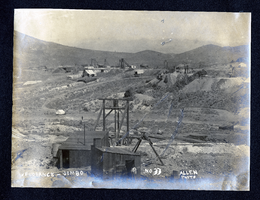
Photograph of Florence and Jumbo Mine sites, Goldfield (Nev.), early 1900s
Archival Collection
Description
Caption: Florance - Jombo No. 33
Image
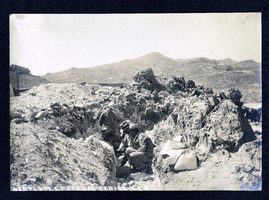
Photograph of men and boy examining ore at Bartlett Lease, early 1900s
Archival Collection
Description
Caption: Bartlett lease rig strike No. 8
Image
Pagination
Refine my results
Content Type
Creator or Contributor
Subject
Archival Collection
Digital Project
Resource Type
Year
Material Type
Place
Language
Records Classification
